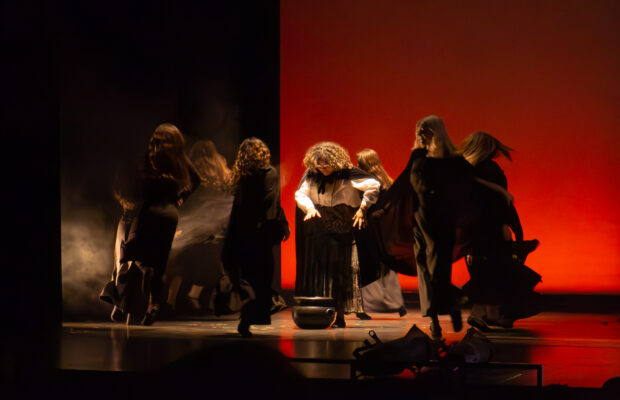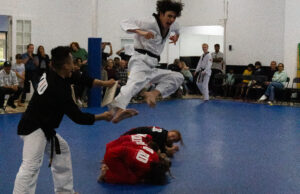“The Crucible” offers insight and student opportunity

On the surface, reading or watching “The Crucible” is a form of entertainment based on a hysteric period, yet diving into the context and moral lessons of our country’s complex past, reveals its ever present applicability to today’s world. From March 14 to 17, the NPHS theater department performed Arthur Miller’s 1953 play, “The Crucible,” and it was also read in 11th and 12th grade English classrooms. Opening night was successful, but student actors still felt nervous before going onstage.
The actors worked diligently to breathe life into the characters, bringing them off the page and onto the stage. Dominic Folino, senior, has been involved in theater since his sophomore year. He played the complex character of John Proctor in “The Crucible,” a man who finds his wife accused of witchcraft, her name proposed by his former lover, Abigail Williams. “[Getting into character is] a little difficult, this [play] was written first just as a medium to be read,” Folino said, “I even had to go through my English notes.”
Kayla Knight, senior, focuses on the history of the Salem Witch Trials when getting into character. “I just try to be in the world [of the play] and in my character as soon as I step on stage so that I’m not really thinking about the fact that I’m acting–it’s just that I’m trying to be that character,” Knight said. She plays Thomas Danforth, presiding judge over the trials who rigidly obeys the law despite its contradictions with morality, relieved with Proctor’s admittance of seeing the devil. Proctor’s confession of witchcraft satisfied Danforth’s pursuit for justice, an endeavor that sparked fear among the citizens of Salem.
Backstage, Folino practices new techniques that ready himself for his scenes. “I used to kind of just suck it up and go on, but for this show, I got some advice from the director about getting into character–it’s more just meditative stuff, like controlling your breathing. A lot of nerves and adrenaline are running through,” Folino said.
Rather than meditating like Folino, Knight anxiously waits backstage during Act I. She is given much time to prepare, and overthink. “I’m just sitting there at my table in the dark like: okay do I know my lines? Does everyone else know their lines? And do I remember my blocking?” Knight said, “All of those things are running through my head, and as soon as the curtain opens, it just goes away.”
In addition to telling a story about the Salem Witch Trials, “The Crucible” serves as an allegory for the political climate in which it was written. In the 1950s, a campaign against communists led by Senator Joseph McCarthy accused government employees with insufficient evidence, leading to employees losing their jobs over false charges. Vanessa Denchfield, an IB Literature and Language teacher who has taught “The Crucible” for over ten years, prepares her students by explaining both historical contexts. “You can analyze it with the idea that it’s an allegory, and you can also at the same time analyze the play as its own cultural production without considering McCarthyism,” Denchfield said.
Ultimately, “The Crucible” provides critical insight of the country’s past and the actors on stage bring it to life. “You get an idea as to why it was written, but it’s always wonderful to see it performed first because there’s just so much magic that is captured,” Folino said.


